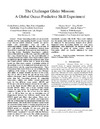Please use this identifier to cite or link to this item:
https://accedacris.ulpgc.es/jspui/handle/10553/47381
| Title: | The Challenger Glider Mission: A global ocean predictive skill experiment | Authors: | Dobson, Collin Mart, Jeffrey Strandskov, Nilsen Kohut, Josh Schofield, Oscar Glenn, Scott Jones, Clayton Webb, Doug Barrera, Carlos Ramos, Antonio Barrera, Carlos |
UNESCO Clasification: | 2510 Oceanografía 3301 Ingeniería y tecnología aeronáuticas |
Keywords: | Ocean temperature Predictive models Data models Forecasting Temperature distribution, et al |
Issue Date: | 2013 | Journal: | Oceans. Conference Record | Conference: | OCEANS 2013 MTS/IEEE San Diego Conference: An Ocean in Common | Abstract: | Ocean forecasting models are an extremely valuable tool for understanding Earth's oceans. Current ocean forecast models assimilate satellite sea surface height and temperature data as well as temperature/salinity profiles from the Argo network of over 3,000 drifters. Though assimilating datasets from these drifters is pertinent, it does create some limitations. Observing System Simulation Experiments routinely indicate that additional profile data, especially profile data that crosses frontal features, are the most influential at reducing forecast uncertainty. Since Argos drifters cannot be controlled and are subject to the oceans currents, areas that would provide critical data to ocean forecasting models are often under sampled. A potential solution to this problem would be to implement datasets provided by Slocum Gliders into the ocean forecasting models. These Autonomous Underwater Gliders are not as limited by the conditions of the oceans as Argos drifters are. Through their ability to sample virtually anywhere in the ocean, they will be able to bridge the gap left by using Argos drifters. This project aims to show the validity of including glider data into forecasting projects by comparing temperature, salinity and surface current projections made by two different ocean models (RTOFS and MyOcean) to the in-situ datasets collected by two gliders: one in the North Atlalntic (Silbo) and one in the South Atlantic (RU29). There was a larger variance found between the two models for temperature and salinity compared to Silbo at the 200 meter level than the 800 meter level. At 200 meters there was also an interesting case of disagreement between the MyOcean model versus the RTOFS model and Silbo's observations. There was a considerable peak in values of salinity and temperature with the MyOcean that was not present with the other two sources of data. The results show that there is good reason for ocean forecasting models to incorporate glider data. As for the temperature comparison with RU29 at 200 m, the RTOFS model was typically 2°C too cold, while the MyOcean model was fairly accurate. For 800 m the RTOFS model was about 1°C too cold, while the MyOcean model was about 1°C too warm. The salinity projections made by both models at both depths were always consistently accurate with RU29. These results indicate that the models, while useful, are not free of error and can be improved by incorporating datasets from gliders. Improved ocean forecasting models will have many applications, most importantly the increased ability of predicting the paths of intense storms, especially hurricanes, which are heavily influenced by ocean conditions. | URI: | https://accedacris.ulpgc.es/handle/10553/47381 | ISSN: | 0197-7385 | Source: | 2013 Oceans - San Diego [ISSN 0197-7385], (2013) |
| Appears in Collections: | Actas de congresos |
SCOPUSTM
Citations
9
checked on Jun 8, 2025
Page view(s)
138
checked on Nov 1, 2024
Download(s)
25
checked on Nov 1, 2024
Google ScholarTM
Check
Share
Export metadata
Items in accedaCRIS are protected by copyright, with all rights reserved, unless otherwise indicated.
